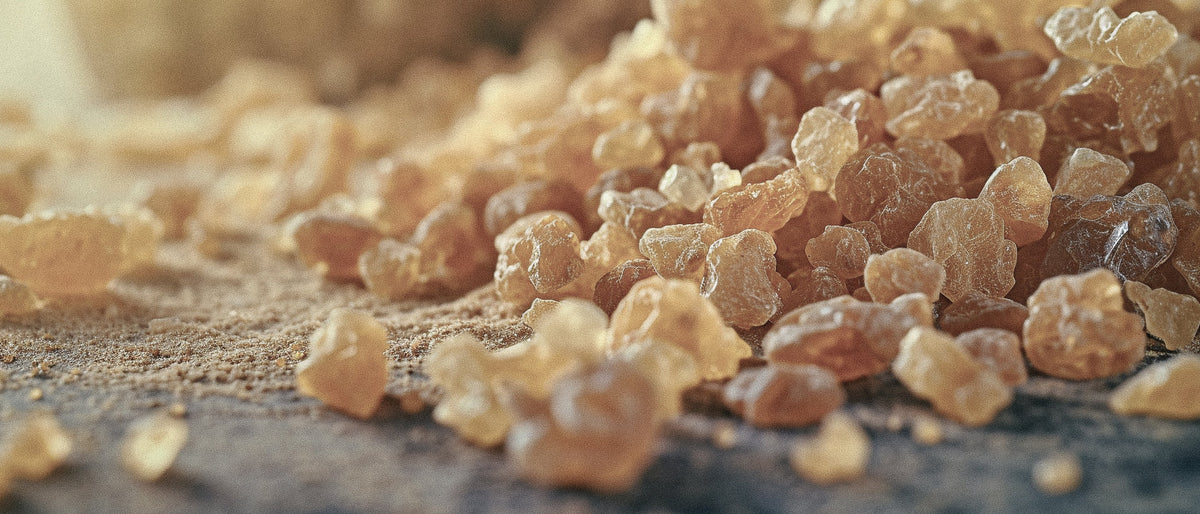
The Science of Elemi: Nature’s Hidden Gem in Niche Fragrance Creation
|
|
Time to read 12 min


|
|
Time to read 12 min
Have you ever caught a whiff of something that stopped you in your tracks—a scent so intriguing that it seemed to tell a story? In the world of perfumery, there are ingredients that do exactly that, and elemi resin is among the most fascinating. This remarkable material has been quietly shaping the niche fragrance industry for centuries, yet remains relatively unknown to the average fragrance enthusiast.
Elemi has become increasingly popular in niche fragrance creation due to its unique olfactory profile. Derived from the Canarium luzonicum tree native to the Philippines, this pale yellow resin offers perfumers something truly special: a material that bridges freshness and depth, providing both lively top notes and lasting base accords. It’s this versatility that makes elemi a standout ingredient in the natural perfume world.
When exploring the realm of artisanal scents, understanding key materials like elemi gives you a deeper appreciation for the craft. Let’s dive into the science, history, and artistry behind this extraordinary resin that’s captivating perfumers and fragrance lovers alike.
Creating a balanced natural perfume often requires ingredients like elemi that can bridge top and base notes. What makes elemi so valuable in perfumery is its complex chemical composition. The resin contains a fascinating array of compounds that contribute to its distinctive scent profile.
The primary components include:
Limonene (53.7%): Provides fresh, citrusy brightness
α-phellandrene (14.5%): Contributes terpenic, woody character
Elemol (10.1%): Adds warm, spicy undertones
These percentages have been verified through gas chromatography-mass spectrometry analysis, revealing why elemi is such a powerhouse in fragrance creation. Beyond these major components, elemi also contains triterpenoid compounds like α-amyrin and β-amyrin, which contribute to its remarkable stability—a crucial quality for natural perfume ingredients.
What’s particularly interesting about elemi is how these compounds interact with each other and with other fragrance materials. The limonene provides an immediate citrus lift, while the elemol creates a lingering warmth that helps anchor the scent. This dual nature makes elemi resin particularly valuable in natural fragrance compositions where synthetic fixatives aren’t used.
The sustainable harvesting of elemi aligns perfectly with the ethos of natural perfume creators. Unlike some fragrance materials that face sustainability challenges, elemi can be harvested without harming the tree, making it an environmentally responsible choice for perfumers committed to ethical sourcing.
The most traditional method produces elemi essential oil, capturing primarily the volatile compounds. This process emphasizes the fresh, citrusy, and piney aspects of elemi. When shopping for niche perfume, you might notice elemi listed among the key notes in many compositions that feature a bright, uplifting character.
The distillation process involves:
Collecting the raw resin
Exposing it to steam, which causes the volatile compounds to evaporate
Cooling and condensing these vapors back into liquid form
Separating the essential oil from the water
The resulting oil is prized for its fresh, lively character and is often used in the top notes of niche cologne and other fragrance compositions.
A more modern approach, supercritical CO₂ extraction, offers perhaps the most faithful representation of the natural material. This method:
Uses carbon dioxide under pressure as the solvent
Operates at lower temperatures, preserving delicate compounds
Leaves no solvent residue in the final product
Captures a broader spectrum of aromatic compounds
Perfumers working with natural fragrance materials appreciate elemi’s ability to enhance other botanical components, especially when extracted using this gentle method that preserves its full complexity.
Perfumers specializing in niche perfume often praise elemi for its versatility and complexity. But what exactly does elemi smell like? Describing scents is always challenging, but elemi’s profile is particularly multifaceted:
Citrus Brightness: A fresh, lemony quality that provides lift and radiance
Pine-Like Clarity: A clean, resinous aspect reminiscent of forest air
Fennel Nuances: A subtle anisic quality that adds complexity
Peppery Spice: A gentle warmth that evolves as the scent develops
Balsamic Depth: A sweet, resinous foundation that provides longevity
What makes elemi truly special is how these facets shift and evolve over time. In the initial moments after application, the citrus and pine aspects dominate. As these volatile compounds evaporate, the spicy and balsamic qualities emerge, creating a beautiful evolution on the skin.
The concentration of elemi in a formula dramatically affects its expression. At lower concentrations (around 0.5%), the fresh, citrusy aspects shine. At higher concentrations (up to 3%), the resinous, balsamic qualities become more prominent. This versatility allows perfumers to use elemi in different ways depending on their creative vision.
When asking what is a niche fragrance, experts often point to the use of unique materials like elemi as a defining characteristic. The distinctive character of elemi has made it a staple in many niche perfume houses that seek to create memorable, signature scents that stand apart from mainstream offerings.
The growing demand for natural fragrance has increased interest in sustainable ingredients like elemi. But this isn’t a new discovery—elemi has a rich historical legacy that spans continents and centuries.
The name “elemi” itself has fascinating origins, believed to derive from an Arabic phrase meaning “above me” or “that which is above”—perhaps referring to the resin’s collection from the upper parts of the tree or to its spiritual significance. This etymology hints at elemi’s long history in trade routes connecting East and West.
In ancient Egypt, elemi was one of the resins used in the mummification process, valued for both its preservative properties and its pleasant aroma. The Egyptians, masters of early perfumery, recognized elemi’s unique qualities thousands of years before modern chemistry could explain them.
In the Philippines, where the Canarium luzonicum tree is native, elemi has been known as the “resin of light” and has played a role in traditional healing practices and spiritual ceremonies. Local communities have developed sustainable harvesting techniques passed down through generations, collecting the resin during the rainy season when it flows most abundantly.
European perfumery discovered elemi through trade routes, with the resin appearing in medicinal and fragrance formulations by the 17th century. Its ability to combine freshness with longevity made it valuable in early cologne formulations, where it helped extend the life of citrus notes that would otherwise quickly fade.
This rich heritage continues to inspire contemporary perfumers, especially those interested in connecting their creations to historical traditions. Elemi contributes both freshness and depth to natural fragrance compositions, providing a link between ancient perfumery practices and modern niche creations.
One of elemi’s most valuable functions is its ability to connect different facets of a fragrance. It can:
Link citrus top notes to woody middle notes
Smooth transitions between fresh openings and balsamic bases
Create coherence in compositions with diverse elements
This bridging quality is particularly valuable in all natural perfume creation because it provides both top and base note characteristics, helping perfumers create well-rounded compositions without synthetic materials.
Elemi has become a favorite material among artisan fragrance creators seeking unique signatures. Smaller, independent perfumers often highlight elemi’s natural complexity as part of their commitment to using high-quality, natural materials. The hands-on approach of artisan fragrance production aligns perfectly with the careful harvesting of elemi resin.
When exploring the best natural perfumes on the market, you’ll frequently find elemi listed among the key ingredients. Perfume critics often note that the best natural perfumes use materials like elemi to create complexity and longevity that rivals conventional fragrances.
The complex chemistry of elemi makes it an ideal fixative for all natural perfume formulations, helping to extend the life of more volatile components. This technical benefit, combined with its beautiful scent profile, explains why elemi continues to gain popularity among perfumers dedicated to natural materials.
Unlike some fragrance materials that require destroying the source plant, elemi is collected through a process similar to tapping maple trees for syrup:
Small incisions are made in the bark of mature Canarium trees
The resin naturally flows out as a protective response
Harvesters collect the resin without harming the tree
Trees can be tapped for many years when properly managed
This sustainable approach allows for continuous production without depleting the resource, making elemi an environmentally responsible choice for perfumers.
The cultivation of Canarium trees offers several environmental benefits:
The trees help prevent soil erosion in their native habitats
They contribute to forest biodiversity
They can be part of agroforestry systems that support multiple species
The harvesting process incentivizes forest preservation rather than clearing
Understanding what is a niche fragrance requires appreciating how perfumers use special ingredients like elemi to create distinctive scent profiles while also considering environmental impact.
Many of the best niche fragrance brands emphasize not just environmental sustainability but also social responsibility. Elemi harvesting provides income for communities in the Philippines, often in rural areas with limited economic opportunities. When these operations follow fair trade principles, they contribute to sustainable development and help preserve traditional knowledge.
The growing interest in ethical sourcing has made transparency about ingredient origins increasingly important in the perfume industry. When exploring the best niche fragrance brands, you’ll notice how they skillfully utilize elemi’s complex character while also highlighting their commitment to responsible sourcing.
Elemi resin contains compounds that support skin health and regeneration. This has made it a valuable ingredient in natural skincare products, where it can help:
Promote elasticity
Support the skin’s natural barrier function
Provide gentle astringent properties
Contribute a pleasant aroma without synthetic fragrances
Many of the best natural perfumes on the market feature elemi as a key ingredient not just for its scent but also for these beneficial properties, creating products that offer both olfactory pleasure and potential wellness benefits.
Beyond traditional perfumery, elemi is finding its way into a broader range of scented products, from home fragrances to personal care items. Its pleasant aroma and potential therapeutic benefits make it versatile beyond just fine fragrance.
Perfumers working with natural fragrance materials appreciate elemi’s ability to enhance other botanical components, making it likely to remain a key player in natural perfumery’s evolution. As techniques for capturing and preserving natural scents continue to advance, we may discover even more facets of elemi’s complex character.
Elemi resin stands as a perfect example of why natural materials continue to fascinate perfumers and fragrance enthusiasts alike. Its complex chemistry, rich history, and versatile olfactory profile make it a standout ingredient in the world of niche fragrance and natural perfume.
The distinctive character of elemi has made it a staple in many niche perfume houses that seek to create memorable, signature scents. Its ability to provide both freshness and longevity, to bridge top notes and base notes, makes it technically valuable while its unique scent profile ensures it brings character to any composition it graces.
As consumers become increasingly interested in the stories behind their fragrances—the ingredients, the sourcing practices, the cultural connections—materials like elemi with their rich heritage and sustainable production are likely to gain even more prominence. The complex chemistry of elemi makes it an ideal fixative for all natural perfume formulations, helping these creations achieve the performance consumers expect.
The next time you encounter elemi in a fragrance description, take a moment to appreciate this remarkable resin—a material that has journeyed from ancient Egyptian temples to modern perfume bottles, bringing its unique character to each stop along the way. In the ever-evolving world of perfumery, elemi represents the perfect balance of tradition and innovation, natural beauty and scientific fascination.
Başer, K. H. C., & Buchbauer, G. (2015). Handbook of Essential Oils: Science, Technology, and Applications (2nd ed.). CRC Press.
Burfield, T. (2000). Natural Aromatic Materials - Odours & Origins. Atlantic Institute of Aromatherapy.
Sell, C. (2006). The Chemistry of Fragrances: From Perfumer to Consumer (2nd ed.). Royal Society of Chemistry.
Steele, V. (2013). The Scent of a Dream: Travels in the World of Coffee. Abrams.
Turin, L., & Sanchez, T. (2008). Perfumes: The A-Z Guide. Penguin Books.
Arctander, S. (1960). Perfume and Flavor Materials of Natural Origin. Elizabeth, NJ: Self-published.
Aftel, M. (2014). Fragrant: The Secret Life of Scent. Riverhead Books.
Calkin, R. R., & Jellinek, J. S. (1994). Perfumery: Practice and Principles. Wiley-Interscience.
Pybus, D. H., & Sell, C. S. (1999). The Chemistry of Fragrances. Royal Society of Chemistry.
Tisserand, R., & Young, R. (2013). Essential Oil Safety: A Guide for Health Care Professionals (2nd ed.). Churchill Livingstone.